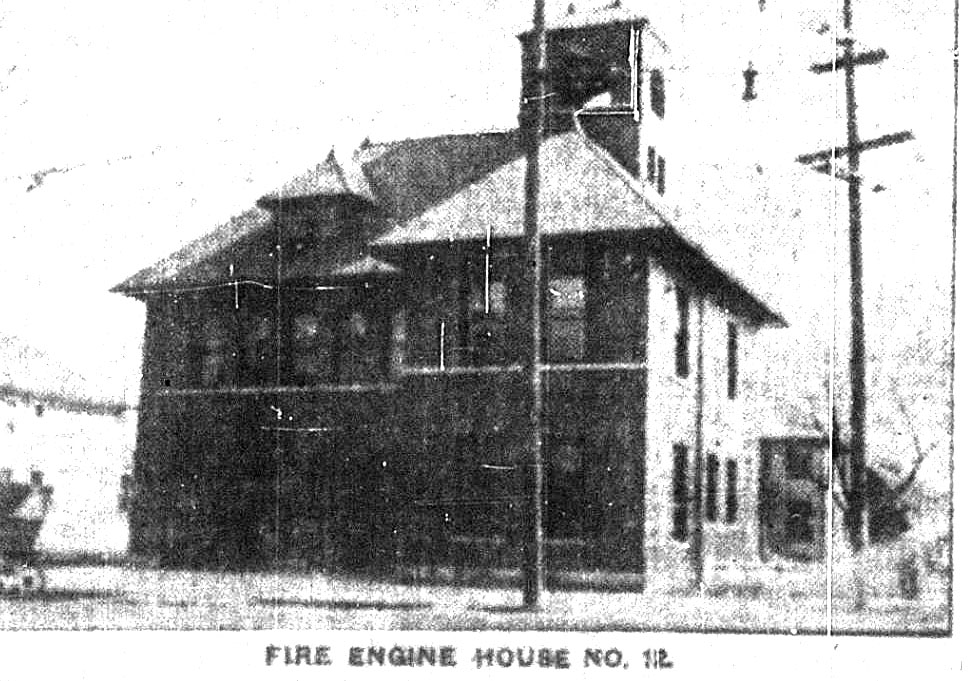|
Mascotted by "Buster", a handsome English bulldog and horsed by "Doc" and
Seal", the former a tried veteran of 19 years service, No. 12 engine house has
settled down after a three months tryout to the steady routine of engine house
live.
No. 12 is situated at the corner of Grandville avenue and Hall street, and is
the latest acquisition to the fire department in engine houses. It was built
last fall and January 22nd seven men were drawn from different houses and
installed at that station.
The house fills a long felt want in that section of the city for residence
building has progressed at a good rate during the last five years. There are
also 15 large manufacturing plants with No. 12's responding limits, which add
materially to the necessity for its existence.
The building is modern in every sense of the word. It is built of light paving
brick, is of neat design and presents a handsome appearance. A tall elm tree on
the east side affords ample shade in the morning. On the west side is an apple
tree growing close to the inside of the walk. When the building was erected
there was talk of cutting the tree down, but a strenuous objection entered by W.
B. Weston, member of the board of police and fire commissioners, previously.
Captain is Peter Nagelkerke
At present the house is equipped with but one hose wagon. Within the next few
weeks a steamer will be installed, dependent upon the arrival of several auto
trucks and carts that have been ordered. When the first arrives the steamer from
No.3 house will be sent to No. 12, together with its horses. The steamer will
conclude the equipment. Seven men comprise the force at the house now. When the
steamer arrives three more men will be added.
The members of No. 12 and their years of service are as follows: Captain Peter
Nagelkerke, 17 years; Lieutenant Wesley L. White, 17 years; Driver Fred
Patterson, 6 years; Thomas McDonald, pipeman, 24 years; John F. Haggerty,
pipeman, 12 years; John E. Cole, pipeman, 13 years, and Benjamin Emans, pipeman,
12 years. Nagelkerke was shifted from No. 6 house, Benjamin Emaus from No. 2,
White from No. 5, and McDonald, Haggerty, Cole and Patterson from No. 1.
"Buster" who is considered by the men of No. 12 as the prize mascot of the
department, is on the job at every fire. The first clang of the bell finds him
pawing at the door, anxious to be the first on the scene.
"Doc", probably the dean of all the fire horses, has a good start on the
--------------- life. Yet for all that he is as frisky, as good looking and as
ready to respond when the alarm sounds as any house in the department. For 19
years he has headed the No. 1 chemical engine and in that time, besides
exercising has responded to 4,106 alarms and has only seen one sick day. As the
old hose wagon is being supplanted by new and modern auto apparatus, so will
"Doc" soon be relegated to the ranks of "a has-been". This probably means that
he will be in service on a milk wagon., statistics showing that the majority of
antiquated fire horses usually are "canned" to the milk routes. Whether "Doc"
will steady down to the slow going delivery horse at once or deliver up a few
impromptu "milk shakes" when the fire alarm sounds, is problematical.
No. 12 Serves Big Territory
The territory of No. 12 comprises everything between Fifth avenue and the
city limits on the south and west and everything east to South Division street.
Among the large factories in its limits are the Grand Rapids Refrigerator
company, Stickley Bros., Michigan Chair company, Excelsior Wrapper company,
Grand Rapids Piano Case company, Nichols & Cox Lumber company, Acme Lumber
company, C. W. Luce & Sons, Lindner Manufacturing company, Keeler Brass works,
Retting Furniture company, Fancy Furniture company, Terrel Equipment company, G.
R. & I. car shops and G. R. & I. freight house. The Coit addition, familiarly
known as the "black hills", did not contain a house 10 years ago. Today there
are over 200 homes on it.
The engine house is 82 x 48 feet. It has a roomy basement, in which is located
the heating plant. The furnace connects directly with the hose tower in such a
manner that when frozen hose is hung in it heat from the furnace and auxiliary
pipes will quickly thaw it out.
The captain's room is situated in a front corner of the second floor. In its
rear is a large bath room and toilet. A shower bath is one of its features. The
dormitory contains 11 beds and is 24 x 28 feet.. At the back and are 11 large
lockers. A foot wall separates the dormitory from the hay loft. Back of this is
the granary.
An office and lounging room, 15 x 15 feet in size, is in one corner of the first
floor. The apparatus room has a cement floor, with drain pipes in the centers,
and is 30 x 26 feet. Back of this room are six stalls. The barn proper adjoins
the stalls. A large shed in the rear of the station house is used for storing
coal and shavings.
|

